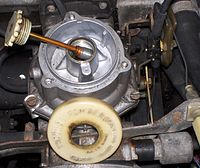黏壺

黏壺(英語:dashpot)是機械系統中與線性系統黏滯阻尼有關的阻抗元件,可通過其中的黏滯流體來減弱衝擊和減緩運動[1][2]。應用中也被稱為緩衝器,也稱作阻尼器。黏壺可以阻滯運動和吸收能量,其產生的阻力隨運動的速度增大而增加,但方向相反。[3]在聚合物研究中,可以將黏壺與彈簧連用構成模型,來表示聚合物材料的黏彈性。在過程和設備圖 (P&ID)中,黏壺的符號是![]() .
.
種類
[編輯]最常見的兩種黏壺是線型黏壺和旋轉型黏壺。
線型黏壺
[編輯]線型黏壺可產生和運動相反的阻力。通常由線性偏差和阻尼係數決定。
旋轉型黏壺
[編輯]旋轉型黏壺會對施加在其上的力矩產生阻力矩,阻力矩正比於轉速,其阻尼係數為阻力矩與角速度的比值。[4]
渦流阻尼器
[編輯]一種比較少見的黏壺是湍流阻尼器,由置於非磁性導體中的大型磁體構成。和平常的黏壺一樣,渦流阻尼器的阻力正比於速度。渦流阻尼器最常用的地方是天平,可以使擺動迅速達到平衡。[5][6][7][8]
單向控制
[編輯]黏壺常常可以通過單向機械支路來允許某一方向上的迅速的無礙運動,而對另一方向的運動產生阻礙。
應用
[編輯]
黏壺是閉門器的常見組成部分,來防止門的猛然關閉。其中的彈簧部件提供關門的力,但黏壺通過黏性液體的流動來抵消一部分力,減慢門的運動。
黏壺通常用於阻尼器和減震器。汽車減震器中的液壓缸就是一個黏壺。通過使用黏壺阻止油門的最終關閉,內燃機中的防熄火機構可以防止發動機在低轉速下熄火。它們也用於化油器,在油門杆完全關閉之前緩衝油門杆的返回,然後允許緩慢完全關閉以減少排放。英國SU化油器的主活塞帶有階梯針,該針固定在燃料流孔中。歧管真空使該活塞上升,從而允許更多燃料進入氣流。黏壺有一個固定的液壓活塞,在主活塞向上移動時對其進行阻尼。當主活塞返回時,活塞中的閥門會禁用阻尼。
黏壺可以用來抵抗較大的衝力和較快的速度。例如在航空母艦甲板上用於攔截蒸汽彈射器。電氣開關設備可在其過電流傳感機制中使用黏壺來降低對短暫事件的反應速度,從而使它們對瞬態誤觸發不那麼敏感,同時仍對持續過載保持敏感。另一種用途是延遲電路的閉合或斷開。這樣的緩衝定時器(Dashpot timer)可以用於例如定時樓梯照明。
黏彈性
[編輯]黏壺代表了固體黏性的,與時間有關的變形性,可以和代表彈性的彈簧一起被用於材料工程模型,來描述物體比如橡膠、肌肉組織等的黏彈性行為。麥克斯韋模型和開爾文-福格特模型分別將彈簧和黏壺串聯和並聯達到這一目的,便於模擬物體的複雜行為比如蠕變和應力鬆弛(stress relaxation)。
參見
[編輯]參考文獻
[編輯]- ^ Oxford English Dictionary. Oxford University Press.
dash-pot, n. a contrivance for producing gradual descent in a piece of mechanism or for preventing vibration or sudden motion, consisting of a cylinder or chamber containing liquid in which a piston moves; a hydraulic buffer.
- ^ dashpot. 術語在線. [2021-12-08]. (原始內容存檔於2021-12-08).
- ^ Mark H. Holmes. Introduction to the Foundations of Applied Mathematics. Springer. 2009: 329.
the resistance force is proportional to the velocity
- ^ Dashpot Types. www.kinetrol.com. [5 August 2020]. (原始內容存檔於2021-12-06).
- ^ Mike Plissi. Update on eddy-current damping experiments (PDF). Laser Interferometer Gravitational-Wave Observatory (LIGO). [2010-05-29]. (原始內容 (PDF)存檔於2010-07-25).
A magnet moving inside a non-magnetic conductive tube has its motion retarded. Retardation force is proportional to velocity of magnet- viscous damping.
- ^ Sodano; Bae; Inman; Belvin. Improved Concept and Model of Eddy Current Damper (PDF). American Society of Mechanical Engineers. June 2006, 128: 294–302. (原始內容 (PDF)存檔於2010-07-28).
This process of the generation and dissipation of eddy current causes the system to function as a viscous damper
- ^ Starin; Neumeister. Eddy Current Damping Simulation and Modeling. Proceedings of the 9th European Space Mechanisms and Tribology Symposium. 19–21 September 2001, 480: 321–326. Bibcode:2001ESASP.480..321S. ISBN 92-9092-761-5.
One major advantage of ECD's is their linearity
- ^ Henry A. Sodano. Development of Novel Eddy Current Dampers for the Suppression of Structural Vibrations (pdf). Virginia Polytechnic Institute and State University. May 5, 2005 [2020-09-26]. hdl:10919/27677.
This damping force can be described as a viscous force due to the dependence on the velocity of the conductor.
